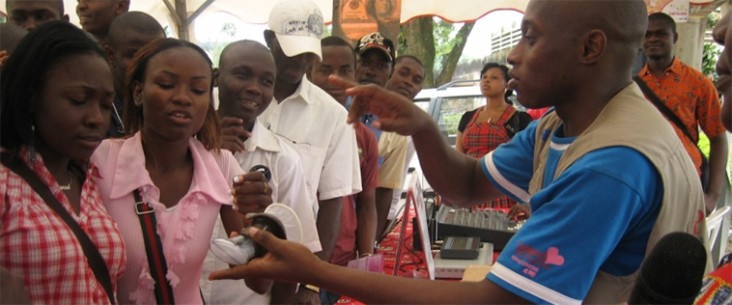- What We Do
- Agriculture and Food Security
- Democracy, Human Rights and Governance
- Economic Growth and Trade
- Education
- Environment and Global Climate Change
- Gender Equality and Women's Empowerment
- Global Health
- Humanitarian Assistance
- Transformation at USAID
- Water and Sanitation
- Working in Crises and Conflict
- U.S. Global Development Lab
Speeches Shim

Low Rates of Condom Use
At a Glance
Condom use is a critical prevention element in a comprehensive, effective and sustainable approach to HIV. While no barrier method is 100 percent effective, correct and consistent use of latex condoms can greatly reduce the risk of transmission of HIV.
Failure to use condoms correctly with every act of intercourse, however, has been shown to increase the risk of HIV transmission. In recent studies, condom use by men at last higher risk sex (with a nonmarital, noncohabiting partner) in Africa ranged from just 13.1 percent in Madagascar (2008 DHS) to 77.3 percent in Zimbabwe (2011 DHS). Statistics on whether a condom was worn at last sex are usually substantially lower and indicate that condoms are generally not used consistently with all partners in most settings.
Consistent condom use is predicated upon a reliable, widely available and accessible supply of condoms. Behavior change programs are also necessary to create demand for correct and consistent condom usage. In many countries, condom supplies have been inconsistent and condom promotional efforts have been insufficient.
USAID’s Response
To address these gaps in condom programming, the U.S. Agency for International Development (USAID)-funded condom programs assist countries in creating a condom programming strategy that addresses key supply and demand issues related to increasing condom use. USAID condom programs have adopted a total market approach to condom programming. A total market approach engages the public sector that gives free condoms, social marketing that gives subsidized condoms and the private sector that sells regular priced condoms. This approach also plans for increased sustainability by reducing reliance on donor subsidies and increasing country ownership.

Different types of female condoms were on display at the Condomize! booth at the XIX International AIDS Conference in Washington, DC.
Kimberly Whipkey, PATH
Globally, USAID condom programming emphasizes key interventions related to improving condom supply and increasing demand. These include:
- Improving access to affordable and accessible male and female condoms and lubricants through condom social marketing projects.
- Creating demand for male and female condoms through evidence-based behavior change programs targeting specific populations.
- Procuring low-cost male and female condoms and lubricants for government and non-governmental condom distribution programs in developing countries.
- Providing technical assistance to build the capacity of national condom supply chains and condom procurement processes.
- Coordinating with other contraceptive supply donors to ensure adequate and uninterrupted condom supplies in relevant countries.
Current Programmatic Highlights
Commodity Fund
USAID centrally finances male and female condoms and lubricants for nonfocus U.S. President’s Emergency Plan for AIDS Relief (PEPFAR) countries. These commodities are provided at no cost to these countries, enabling dozens of countries to make condoms available to poor or vulnerable individuals for free or at highly subsidized prices. In FY 2012, mainly with Commodity Fund funding, USAID provided 770 million male and female condoms to 37 countries in USAID’s Africa, Asia, Europe, Eurasia and Latin America and Caribbean regions.
Condom Emergency Fund

Staff load family planning and other health commodities into a truck as part of the Delivery Team Topping Up system in Zimbabwe. 2009.
USAID | DELIVER PROJECT
For a variety of reasons, many countries are experiencing condom stock-outs and shortages that threaten prevention efforts. The solution to these problems lies in improved planning, forecasting, procurement and distribution; people who need condoms should have reliable access to them at all times, even as partner governments and others work to build better systems. In order to address condom stock-outs in the short-term, PEPFAR has set aside funds through USAID for a “Condom Emergency Fund” to support emergency procurements of male and female condoms in former PEPFAR focus countries. Emergency condom needs generally include pending condom stock-outs or shortages caused by failure or delay in another donor supplying condoms, inadequate in-country funding, an unanticipated spike in demand and various failures of the country supply chain system to adequately forecast and supply condoms. When one of these situations occurs, PEPFAR countries can access rapidly expedited orders of condoms through the Condom Emergency Fund for focus countries or the Commodity Fund for nonfocus countries.
Technical Assistance for Supply Chain Management of Condoms
Through the USAID | DELIVER PROJECT, USAID is funding technical assistance to improve supply planning, procurement systems and distribution systems for condoms in countries that have had problems maintaining consistent condom supplies. The USAID | DELIVER PROJECT works closely with host country governments to identify issues in supply chain management of condoms and to devise solutions to these concerns. As problems in the supply chain management of condoms tend to be country specific, the technical assistance provided works closely with each individual country to identify its specific needs and solutions.
Additional Resources
- USAID Condom Fact Sheet and Supplemental Technical Information on Condoms [PDF, 210 KB]
- USAID Technical Issue Brief: The Female Condom is Safe and Effective [PDF, 228KB]
- USAID Technical Issue Brief: Condom Use - How it Relates to HIV and STI Prevention [PDF, 171KB]
- Total Market Initiatives for Reproductive Health [PDF, 1.3MB]
- Technical Considerations for FY 2013 COPs and ROPs [PDF, 4.3MB]
- Male Latex Condom: Specification, Prequalification and Guidelines for Procurement [PDF, 1.7MB]
- Use and Procurement of Additional Lubricants for Male and Female Condoms: Advisory Note [PDF, 198KB]
- Female Condom: Generic Specification, Prequalification and Guidelines for Procurement [PDF, 1.8MB]
- UNFPA Prequalified Male and Female Condom Suppliers [PDF, 10KB]

Comment
Make a general inquiry or suggest an improvement.